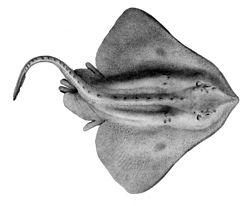| Pari Julat zaman: [1]
| |
|---|---|

| |
| Setoka pelagik, Pteroplatytrygon violacea | |
| Pengelasan saintifik | |
| Domain: | Eukaryota |
| Alam: | Haiwan |
| Filum: | Chordata |
| Kelas: | Chondrichthyes |
| Subkelas: | Elasmobranchii |
| Divisi: | Batomorphi Compagno, 1973 |
| Orders | |
| Sinonim | |
| |

Batomorphi ialah sebuah divisi[2] ikan berawan yang biasa dipanggil pari; takson ini turut dikenali sebagai superorder Batoidea, namun edisi ke-5 Fishes of the World memasukkannya ke dalam divisi Batomorphi.[3] Ia dan saudara rapatnya, yu, membentuk subkelas Elasmobranchii. Pari ialah kumpulan terbesar ikan berawan, dengan lebih 600 spesies dalam 26 keluarga. Pari dibezakan dengan tubuh yang leper, sirip dada besar yang bercantum dengan kepala, dan lekah insang yang terletak di muka depan.
Lebih 600 spesies didapati tersebar di air tawar dan laut baik air dalam, mahupun cetek di kawasan tropika.[4]
Anatomi
Batoid ini bertubuh leper, dan merupakan ikan berawan sama seperti yu, bermaksud ia mempunyai rangka tanpa tulang yang dibina daripada rawan mulur yang tegar. Kebanyakan batoid mempunyai lubang depan menutupi insang di bahagian bawah badan ikan: banyak spesies pari mempunyai lima lubang manakala spesies keluarga Hexatrygonidae mempunyai enam lubang.
Berhampiran pangkal ekor pari terdapat sengat sekitar 8-inci yang diselitupi dengan bahan yang sama yang membentuk sisik yu, yang dikenali sebagai dentikel dermis. Hujung ini, yang menjadi keras dan tegang apabila pari berasa terancam, berbentuk seperti pisau daging bergerigi dan memiliki bisa yang mengancam pemangsa. Sebahagian besar racun itu sendiri adalah toksin berasaskan protein yang menyebabkan kesakitan pada mamalia dan boleh juga mengubah kadar degupan jantung dan pernafasan, mengikut pada Makmal Mote Marine. Pari jarang menyerang manusia, bagaimanapun sekiranya ia dipijak, pari akan gunakan sengatnya sebagai suatu bentuk pertahanan diri," mengikut Nancy Passarelli dan Andrew Piercy bagi Muzium Sejarah Semula Jadi Florida. "Walaupun ditikam oleh ekor pari amat menyakitkan, ia adalah jarang menjadi ancaman kepada nyawa manusia."
Telur-telur pari disenyawakan dari dalam yang dapat mengelakkan dimangsakan serta memelihara benih jantan dan tenaga yang digunakan sepenuhnya semasa pembiakan.[5]
Taksonomi
Spesies-spesies pari dapat digolongkan kepada empat kelompok utama:
| Order | Imej | Nama umum | Keluarga | Genus | Spesies | Ulasan | |||
|---|---|---|---|---|---|---|---|---|---|
| Total | |||||||||
| Myliobatiformes | 
|
Setoka dan saudaranya | 10 | 29 | 223 | 1 | 16 | 33 | [a][6] |
| Rajiformes | 
|
Sahi dan saudaranya | 5 | 36 | 270 | 4 | 12 | 26 | [b] |
| Torpediniformes | 
|
Pari kebas | 4 | 12 | 69 | 2 | 9 | [c][7] | |
| Rhinopristiformes | 
|
Yu kemejan dan saudaranya | 1 | 2 | 5–7 | 3–5 | 2 | [d][8] | |


Eschmeyer's Catalog of Fishes mengelaskan pari berikut:[9]
- Order Torpediniformes
- Keluarga Platyrhinidae D. S. Jordan, 1923 (pari kikir)
- Keluarga Narkidae Fowler, 1934 (pari karas)
- Keluarga Narcinidae, Gill, 1862 (pari karan)
- Keluarga Hypnidae Gill, 1862 (pari keranda)
- Keluarga Torpedinidae Henle 1834 (pari torpedo)
- Order Rhinopristiformes
- Keluarga Trygonorrhinidae Last, Séret & Naylor, 2016 (pari banjo)
- Keluarga Rhinobatidae Bonaparte, 1835 (yu kemejan)
- Keluarga Rhinidae J. P. Müller & Henle, 1841 (yu kia-kia atau pari kekeh)
- Keluarga Glaucostegidae Last, Séret & Naylor, 2016 (yu kemejan gergasi)
- Keluarga Pristidae Bonaparte, 1835 (pari gergaji)
- Order Rajiformes
- Keluarga Rajidae Blainville, 1816 (sahi hidung keras)
- Keluarga Arhynchobatidae Fowler, 1934 (sahi hidung lembut)
- Keluarga Gurgesiellidae de Buen, 1959 (sahi katik)
- Keluarga Anacanthobatidae von Bonde & Swart, 1923 (sahi kaki)
- Order Myliobatiformes
- Keluarga Zanobatidae Fowler. 1934 (pari ceper)
- Keluarga Hexatrygonidae Heemstra & M. M. Smith, 1980 (setoka insang enam)
- Keluarga Dasyatidae D. S. Jordan & Gilbert, 1879 (pari ketuka)
- Subkeluarga Dasyatinae D. S. Jordan & Gilbert, 1879 (setoka)
- Subkeluarga Neotrygoninae Castelnau, 1873 (setoka muncung pendek)
- Subkeluarga Urogymninae Gray, 1851 (ketuka)
- Subkeluarga Hypolophinae Stromer, 1910 (setoka ekor lembu)
- Keluarga Potamotrygonidae Garman, 1877 (setoka neotropika)
- Subkeluarga Styracurinae Carvalho, Loboda & da Silva 2016 (ketuka)
- Subkeluarga Potamotrygoninae Garman 1877 (setoka sungai)
- Keluarga Urotrygonidae McEachran, Dunn & Miyake, 1996 (setoka bulat Amerika)
- Keluarga Gymnuridae Fowler, 1934 (pari kelawar)
- Keluarga Plesiobatidae K. Nishida, 1990 (pari lembik merah)
- Keluarga Urolophidae J. P. Müller & Henle 1841 (setoka bulat atau tetoka)
- Keluarga Aetobatidae Agassiz, 1858 (pari lang pelagik)
- Keluarga Myliobatidae Bonaparte, 1835 (pari lang)
- Keluarga Rhinopteridae D. S, Jordan & Evermann, 1896 (pari hidung lembu)
- Keluarga Mobulidae Gill, 1893 (pari paus atau pari kaluk)
Nota
- ^ Myliobatiformes include stingrays, butterfly rays, eagle rays, and manta rays. They were formerly included in the order Rajiformes, but more-recent phylogenetic studies have shown that they are a monophyletic group, and that its more-derived members evolved their highly flattened shapes independently of the skates.[6]
- ^ Rajiformes include skates, guitarfishes, and wedgefishes. They are distinguished by the presence of greatly enlarged pectoral fins, which reach as far forward as the sides of the head, with a generally flattened body. The undulatory pectoral fin motion diagnostic to this taxon is known as rajiform locomotion. The eyes and spiracles are located on the upper surface of the body, and the gill slits on the underside. They have flattened, crushing teeth, and are generally carnivorous. Most species give birth to live young, although some lay eggs inside a protective capsule or mermaid's purse.
- ^ The electric rays have electric organs in their pectoral fin discs that generate electric current. They are used to immobilize prey and for defense. The current is strong enough to stun humans, and the ancient Greeks and Romans used these fish to treat ailments such as headaches.[7]
- ^ The sawfishes are shark-like in form, having tails used for swimming and smaller pectoral fins than most batoids. The pectoral fins are attached above the gills as in all batoids, giving the fishes a broad-headed appearance. They have long, flat snouts with a row of tooth-like projections on either side. The snouts are up to 1.8 metres (6 ft) long, and 30 centimetres (1 ft) wide, and are used for slashing and impaling small fishes and to probe in the mud for embedded animals. Sawfishes can enter freshwater rivers and lakes. Some species reach a total length of 6 metres (20 ft). All species of sawfish are endangered or critically endangered.[8]
Rujukan
- ^ Aschliman, Neil C.; Nishida, Mutsumi; Miya, Masaki; Inoue, Jun G.; Rosana, Kerri M.; Naylor, Gavin J.P. (2012). "Body plan convergence in the evolution of skates and rays (Chondrichthyes: Batoidea)". Molecular Phylogenetics and Evolution. Elsevier BV. 63 (1): 28–42. doi:10.1016/j.ympev.2011.12.012.
- ^ Nelson, Joseph Schieser (2016). Fishes of the world (ed. Fifth). Hoboken, New Jersey: John Wiley & Sons. ISBN 978-1-119-17484-4.
- ^ Nelson, J.S.; Grande, T.C.; Wilson, M.V.H. (2016). Fishes of the World (ed. 5th). Hoboken, NJ: John Wiley & Sons. m/s. 80. doi:10.1002/9781119174844. ISBN 978-1-118-34233-6. LCCN 2015037522. OCLC 951899884. OL 25909650M.
- ^ Helfman, Gene S. (2013). "Fishes". Encyclopedia of Biodiversity (ed. ke-2). m/s. 456–476.
- ^ "Reproduction overall". Risk Section, Bedford Institute of Oceanography & Marine Fish Species. Canadian Shark Research Lab. Skates and rays of Atlantic Canada. Northwest Atlantic Fisheries Center. Diarkibkan daripada yang asal pada 16 Januari 2015. Dicapai pada 27 Mei 2012.
- ^ a b Nelson, J.S. (2006). Fishes of the World (ed. fourth). John Wiley. m/s. 69–82. ISBN 978-0-471-25031-9.
- ^ a b Bullock, Theodore Holmes; Hopkins, Carl D.; Popper, Arthur N.; Fay, Richard R. (2005). Electroreception. Springer. m/s. 5–7. ISBN 978-0-387-23192-1.
- ^ a b Faria, Vicente V.; McDavitt, Matthew T.; Charvet, Patricia; Wiley, Tonya R.; Simpfendorfer, Colin A.; Naylor, Gavin J.P. (2013). "Species delineation and global population structure of critically endangered sawfishes (Pristidae)". Zoological Journal of the Linnean Society. 167: 136–164. doi:10.1111/j.1096-3642.2012.00872.x.
- ^ "Eschmeyer's Catalog of Fishes Classification". California Academy of Sciences. Dicapai pada 29 October 2024.








